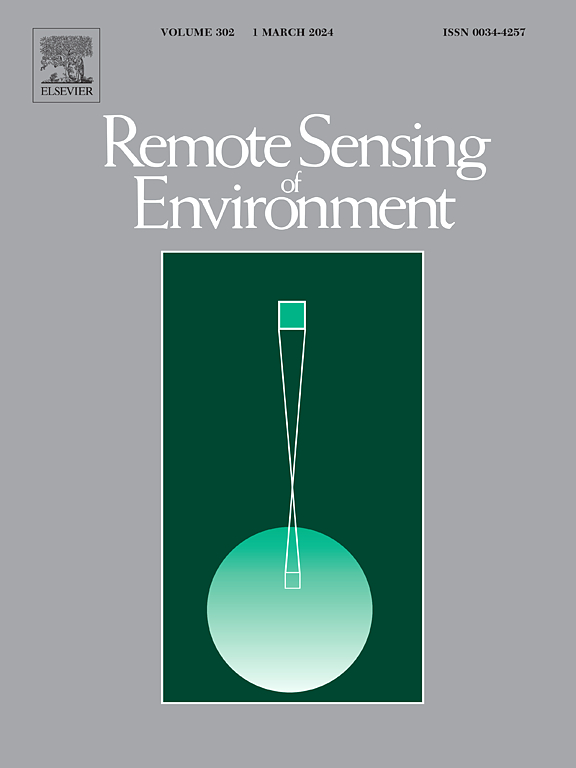New 30-m resolution dataset reveals declining soil erosion with regional increases across Chinese mainland (1990–2022)
IF 11.1
1区 地球科学
Q1 ENVIRONMENTAL SCIENCES
引用次数: 0
Abstract
Hydraulic erosion-induced soil loss critically undermines soil fertility, leading to vegetation degradation, reduced crop yields, and increased flood and pollution risks, thereby threatening food security, ecological integrity, and economic stability. Existing soil erosion estimations using the Revised Universal Soil Loss Equation (RUSLE) model are constrained by the absence of high-resolution (30 ) nationwide rainfall data, significant spatial and temporal inconsistencies among multi-source data, and limited regional adaptability of empirical RUSLE parameters. To address these challenges, we developed the first 30- resolution Hydraulic Soil Erosion Dataset (CSWED) for Chinese mainland, spanning from 1990 to 2022. This was achieved by implementing a Random Forest (RF) interpolation method to generate 30- annual rainfall data and designing a multi-equation combined vegetation cover management factor tailored to China’s diverse soil characteristics. The mean absolute error (MAE) compared to the China Soil and Water Conservation Bulletin was 9.48%, and the CSWED illustrates good consistency with collected runoff plot observation data, significantly surpassing the accuracy of existing publicly available datasets. Our analysis reveals a predominant influence of slope length, steepness, and support practice factors on soil erosion, coupled with a synergistic effect of vegetation cover and topography. Notably, soil erosion in Chinese mainland has exhibited an overall decreasing trend from 1990 to 2022, with significant reductions in light, moderate, and severe erosion categories by 31.70%, 22.24%, and 44.74%, respectively. Also, the sensitivity of soil erosion in 2022 was dominated by strong sensitivity and moderate sensitivity, accounting for 74.149 % and 14.072 %. Then, the decrease in cropland area creates a decrease in soil erosion of 123.54 from 1990 to 2022, while for every additional hectare of forested area, soil erosion was reduced by 58.67 . Special attention should be given to the substantial expansion of soil erosion brought on by extreme rainfall in the Middle and Lower Yangtze River (MLYR) and Southwest China (SWC), where mean soil erosion was 11.71 and 15.79 , respectively, accounting for 60% of the national total.
新30 m分辨率数据集揭示中国大陆土壤侵蚀随区域增加而下降(1990-2022)
水力侵蚀导致的水土流失严重破坏了土壤肥力,导致植被退化、作物减产、洪水和污染风险增加,从而威胁到粮食安全、生态完整和经济稳定。基于修正通用土壤流失方程(RUSLE)模型的现有土壤侵蚀估算受到缺乏高分辨率(30 m)全国降雨量数据、多源数据之间存在显著的时空不一致性以及经验RUSLE参数区域适应性有限等因素的制约。为了应对这些挑战,我们开发了中国大陆第一个30米分辨率的水力土壤侵蚀数据集(CSWED),时间跨度为1990年至2022年。通过采用随机森林(RF)插值方法生成30 m年降雨量数据,并设计适合中国不同土壤特征的多方程组合植被覆盖管理因子,实现了这一目标。与中国水土保持公报相比,平均绝对误差(MAE)为9.48%,与径流样地观测数据具有较好的一致性,显著优于现有公开数据集的准确性。我们的分析揭示了坡长、坡度和支护实践因素对土壤侵蚀的主要影响,以及植被覆盖和地形的协同效应。值得注意的是,1990 - 2022年,中国大陆土壤侵蚀总体呈减少趋势,轻度、中度和重度侵蚀的减少幅度分别为31.70%、22.24%和44.74%。2022年土壤侵蚀敏感性以强敏感性和中敏感性为主,分别占74.149%和14.072%。然后,耕地面积的减少产生水土流失减少123.54 t /款hm2从1990年到2022年,而对于每公顷的森林地区,水土流失降低了58.67 t。应特别注意水土流失的大量扩张带来的极端降雨在长江中下游(MLYR)和中国西南地区(SWC),平均土壤侵蚀是11.71 / (hm2a)和15.79 t / t (hm2a),分别占全国总数的60%。
本文章由计算机程序翻译,如有差异,请以英文原文为准。
求助全文
约1分钟内获得全文
求助全文
来源期刊

Remote Sensing of Environment
环境科学-成像科学与照相技术
CiteScore
25.10
自引率
8.90%
发文量
455
审稿时长
53 days
期刊介绍:
Remote Sensing of Environment (RSE) serves the Earth observation community by disseminating results on the theory, science, applications, and technology that contribute to advancing the field of remote sensing. With a thoroughly interdisciplinary approach, RSE encompasses terrestrial, oceanic, and atmospheric sensing.
The journal emphasizes biophysical and quantitative approaches to remote sensing at local to global scales, covering a diverse range of applications and techniques.
RSE serves as a vital platform for the exchange of knowledge and advancements in the dynamic field of remote sensing.
 求助内容:
求助内容: 应助结果提醒方式:
应助结果提醒方式:


